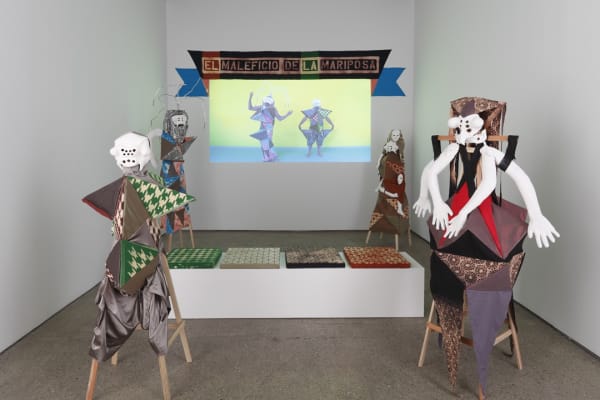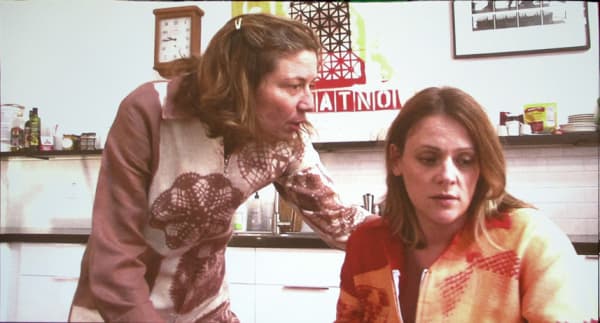The Butterfly's Evil Spell: Lara Schnitger & My Barbarian
The Butterfly's Evil Spell is a collaboration among the three members of LA based collective My Barbarian (Malik Gaines, Jade Gordon and Alexandro Segade) and sculptor Lara Schnitger. Playing between the dramatic spaces of fantasy and realism, the piece uses a fragmentary Symbolist theater text from 1920 by Spanish playwright Federico Garcia Lorca, entitled El Maleficio de La Mariposa, as a starting point. The artists responded with a performance video and installation that re-stages scenes from the play in elaborate sculptural costumes. The group also generated original material drawn from the circumstances in their own interconnected lives, shot on location in their shared LA studio, extending a relationship between imagination and social reality.
El Maleficio de La Mariposa, with a cast of talking insects, tells the story of a mother beetle whose son is "going to be a poet" against her wishes. The son, in another scene, abandons his girlfriend Sylvia because he is "in love with the butterflies," a wistful declaration that carries notes of both poetry and prohibited sexual desire, linking the two. The artists perform these scenes in the video, wearing masks and costumes that become sculptures in the installation. In complementary scenes, the artists act out episodes that reflect their own lives: Gordon, who is pregnant, talks to Schnitger, who has a five year old, about her anxieties; Gaines and Segade, a gay married couple, re-negotiate the complexities of their long-term relationship. The Butterfly's Evil Spell draws parallels between feminist and queer political identities while locating the space for making these connections in the ludic realm of play. Emphasizing the theatrical conditions of this play-space, the video begins with a sung adaptation of Golden Age Spanish playwright Calderon de La Barca's famous Life is A Dream soliloquy, and ends with the dance of the butterflies, in which the four artists become a chorus line of fabric-clad dancers whose wings are decorated with slogans from the women's and gay right's movements of the 70s (when most of the members of the group were born), finally leading them to strip off their costumes and reconnect with the imminence of their bodies. My Barbarian is a collective consisting of Malik Gaines, Jade Gordon and Alexandro Segade, founded in Los Angeles in 2000.
My Barbarian's interdisciplinary performance, video, music and installation projects use fantasy, humor, camp and clashing aesthetic sensibilities to playfully reenact artistic, political, social and historical situations. My Barbarian's solo exhibitions include “The Night Epi$ode” at Participant Inc., New York, 2009 and the Hammer Museum, Los Angeles, 2010; “Ecos de los Ecos” at Museo El Eco, Mexico City, 2010; “Broke People's Baroque Peoples' Theater” at Human Resources, Los Angeles, 2012. The group has presented performance works internationally and has been included in the 2005 and 2007 Performa Biennials, the 2006 and 2008 California Biennials, the 2007 Montreal Biennial and the 2009 Baltic Triennial. Other performance sites have included MoMA, The Kitchen, New Museum, Whitney Museum, and Joe's Pub (NYC), LACMA, MOCA, REDCAT (LA), Power Plant, (Toronto), De Appel (Amsterdam), El Matadero (Madrid), Peres Projects (Berlin), Torpedo (Oslo), Townhouse Gallery (Cairo) and many others. My Barbarian has participated in group shows at the Studio Museum in Harlem; ICA Philadelphia; Hyde Park Art Center, Chicago; MOCA Miami; ICA London; Den Haag Sculptuur, Netherlands; CCA, Tel Aviv; Anton Kern Gallery in New York, and many others. My Barbarian has received grants from Creative Capital (2012), Art Matters (2008), and the City of LA Cultural Affairs Department (2010). Their work has been discussed in the New Yorker, New York Times, LA Times, LA Weekly, Artforum, Art in America, Frieze, various international newspapers, and in José Muñoz’s book “Cruising Utopia: The Then and There of Queer Futurity.”







